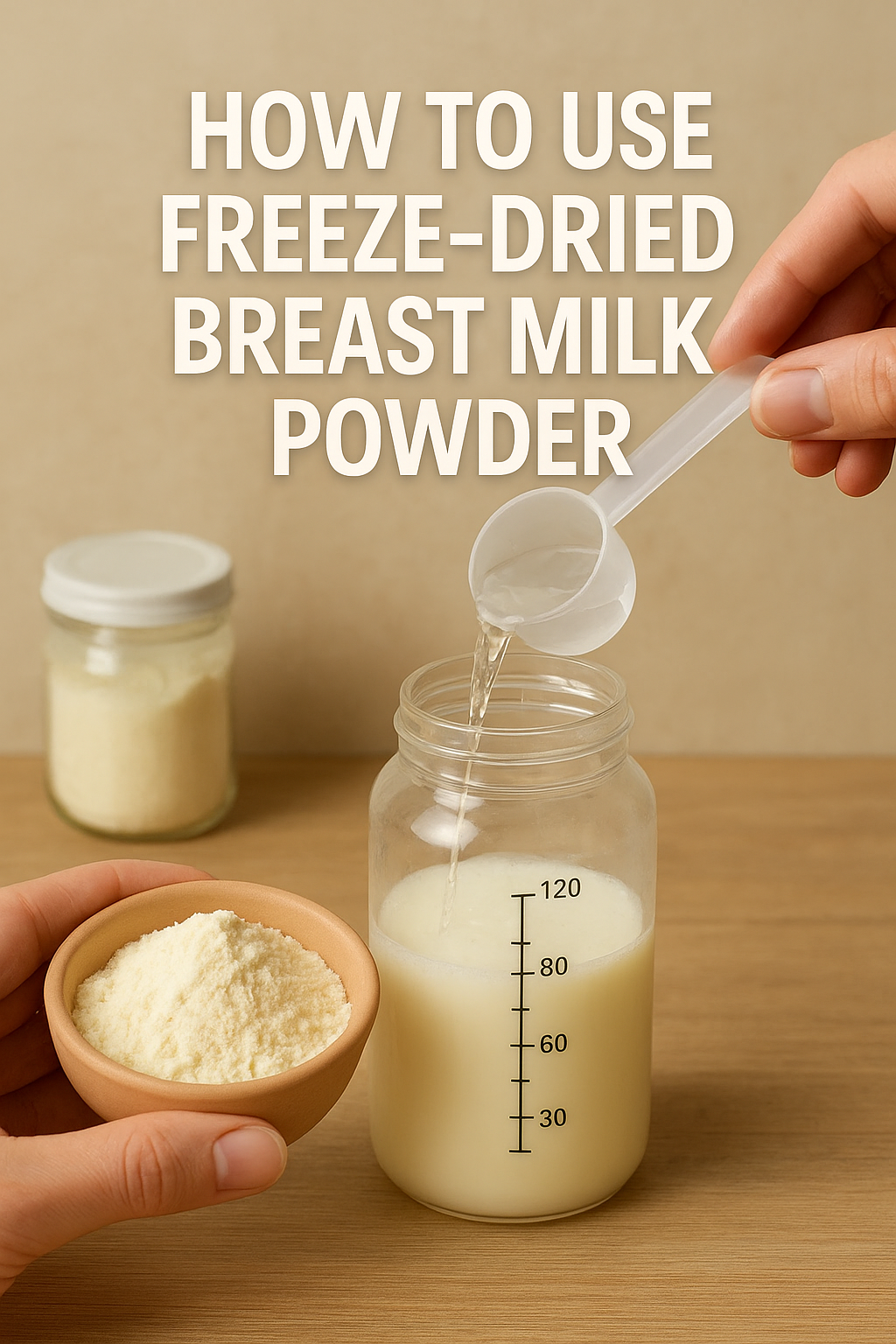
How To Use Freeze-Dried Breast Milk Powder
Share
Breast milk is one of nature’s most valuable gifts — rich in antibodies, nutrients, and essential enzymes that support your baby’s health and immunity. Yet, preserving it for long-term use can be challenging. That’s where freeze-dried breast milk powder comes in — a convenient, safe, and nutrient-preserving solution for busy or traveling mothers.
In this comprehensive guide, we’ll walk you through exactly how to use freeze-dried breast milk powder, covering every aspect from the rehydration guide and storage tips to feeding methods, nutrition insights, and practical baby care tips.
Whether you’ve already freeze-dried your milk or are considering the process, this step-by-step guide ensures you can use it confidently and safely for your little one.
Understanding Freeze-Dried Breast Milk Powder
Freeze-drying is a gentle dehydration technique that removes moisture from milk while maintaining up to 97% of its nutritional content. This method transforms liquid milk into a dry, lightweight powder that can be easily rehydrated when needed.
Unlike traditional freezing, which requires strict temperature control, freeze-dried breast milk powder remains stable at room temperature for months — making it perfect for travel, emergency use, or long-term storage.
You can explore more about the science and benefits of this process at WonderBewbz, a trusted brand specializing in freeze-dried breast milk powder.
Why Choose Freeze-Dried Breast Milk Powder?
For many mothers, the main challenge lies in keeping milk safe and nutritious over time. Freezing works well for short-term use, but it’s not always convenient, especially during travel or power outages.
Here’s why powdered breast milk stands out:
-
Nutrient Preservation – Freeze-drying maintains the milk’s original composition, including proteins, fats, and immune-boosting antibodies.
-
Easy Storage – No need for freezers or coolers. Simply store the powder in a cool, dry place.
-
Portability – Lightweight and travel-friendly, ideal for mothers on the go.
-
Quick Preparation – Rehydrates instantly with sterile water.
-
Reduced Waste – Each portion can be reconstituted as needed, preventing milk spoilage.
Before you start, it helps to understand breast milk storage basics so that you can preserve expressed milk properly before freeze-drying.
Step-by-Step Rehydration Guide
Turning powdered breast milk back into liquid form is simple but requires precision to ensure safety and consistency. This rehydration guide will help you restore your milk to its natural state effectively.
1. Gather Your Supplies
You’ll need:
-
Freeze-dried breast milk powder
-
Sterilized bottle or container
-
Warm, sterile or boiled water (cooled to around body temperature)
-
Measuring scoop or spoon
Ensure all items are clean and dry to prevent contamination.
2. Measure Correctly
Follow the reconstitution ratio provided by your freeze-drying service. Most recommend 1 part milk powder to 3–4 parts water, but this can vary based on dehydration levels.
3. Mix Thoroughly
Pour warm water into a sterilized bottle, add the powder, and swirl or shake gently until fully dissolved. Avoid using extremely hot water, which can destroy delicate nutrients.
4. Check Temperature
Before feeding, always test the milk temperature for baby by placing a few drops on your wrist. It should feel comfortably warm, not hot.
5. Use Promptly
Rehydrated milk should be consumed within 1–2 hours and not refrozen or stored for later use.
Proper Feeding Methods
Feeding your baby rehydrated breast milk is no different from using freshly expressed milk. Here are some important feeding methods and safety considerations to keep in mind.
1. Use Sterile Feeding Bottles
Clean and sterilize all feeding equipment to prevent bacterial contamination.
2. Gentle Mixing
Always swirl the milk instead of shaking vigorously. Shaking may break down some of the milk’s natural fat molecules.
3. Feed Immediately
Once rehydrated, milk should be fed soon after preparation to maintain its freshness and nutritional quality.
4. Avoid Reheating
Never microwave rehydrated breast milk. It can create hot spots that may harm your baby’s mouth and degrade nutrients. Instead, use warm water to gently reheat if necessary.
Best Storage Tips for Freeze-Dried Breast Milk Powder
Proper storage plays a crucial role in keeping powdered milk fresh and safe. These storage tips will help maintain its quality for months.
1. Keep It Airtight
Store the powder in vacuum-sealed or airtight containers to prevent moisture absorption.
2. Avoid Sunlight and Heat
Keep powdered milk away from direct sunlight, stoves, or humid areas. Excess heat can damage nutrients.
3. Use Dry Utensils
Always use a dry spoon when scooping powder. Even a small drop of water can cause clumping or spoilage.
4. Label Clearly
Write down the date of freeze-drying and batch number for easy tracking.
5. Check for Changes
Before use, inspect the powder for any discoloration, unusual odor, or clumping. If found, discard it immediately.
Nutritional Benefits of Freeze-Dried Breast Milk
Freeze-dried milk maintains almost all the natural goodness of fresh breast milk. Here’s what your baby still gets after rehydration:
-
Antibodies and Enzymes – Support immune health and gut development.
-
Healthy Fats and DHA – Crucial for brain and vision growth.
-
Proteins and Carbohydrates – Provide balanced nutrition and energy.
-
Vitamins and Minerals – Ensure healthy development.
Freeze-drying does not alter the milk’s nutritional composition when done professionally. It remains a superior alternative to formula feeding, as explained in breast milk vs formula.
Baby Care Tips When Using Rehydrated Milk
Feeding your baby with rehydrated milk should be done thoughtfully. Here are a few baby care tips to ensure safe and happy feeding experiences:
-
Monitor Reaction – Observe your baby for any allergic responses or discomfort after feeding.
-
Check Feeding Temperature – Always ensure the milk is at body temperature.
-
Hygiene First – Wash your hands and clean bottles thoroughly before preparation.
-
Follow Pediatrician Advice – For newborns or preemies, always confirm feeding ratios with your doctor.
- Discard Leftovers – Never reuse milk that has been left at room temperature beyond two hours.
When to Use Freeze-Dried Breast Milk Powder
This versatile solution is perfect for:
-
Working mothers who want to maintain feeding consistency while away.
-
Traveling families without refrigeration access.
-
Emergency storage in case of power outages.
-
Long-term preservation for future use or donation.
If you plan to increase your milk production before freeze-drying, explore how to increase breast milk supply and foods that boost milk production.
Common Mistakes to Avoid
While using powdered breast milk is simple, certain mistakes can compromise its safety or quality:
-
Using unsterilized water – Always use boiled, cooled water.
-
Incorrect measurements – Follow your service’s rehydration guide exactly.
-
Storing in humid areas – Moisture can spoil the powder.
-
Reusing leftover milk – Rehydrated milk should never be reused.
- Microwaving – Heat destroys valuable nutrients.
Comparing Freeze-Dried Milk with Fresh and Frozen Milk
|
Feature |
Fresh Breast Milk |
Frozen Milk |
Freeze-Dried Milk Powder |
|
Shelf Life |
4–5 days |
Up to 6 months |
6–12 months |
|
Storage Needs |
Refrigerator |
Freezer |
Room Temperature |
|
Nutrient Retention |
100% |
85–90% |
95–97% |
|
Travel-Friendly |
No |
Limited |
Yes |
|
Preparation |
None |
Requires thawing |
Add water |
Freeze-drying clearly offers a perfect balance of nutrition, safety, and convenience.
Addressing Common Questions About Nutrition
Parents often worry whether freeze-dried milk maintains nutrition as effectively as fresh milk. The answer is yes — when properly freeze-dried, it retains immune-boosting properties, enzymes, and essential fats crucial for your baby’s growth.
If you notice a slight metallic taste in breast milk after rehydration, it’s due to natural oxidation of fats and not a sign of spoilage.
Long-Term Preservation and Safety
Here’s how to ensure your powdered milk stays safe for extended periods:
-
Keep the container sealed tightly after each use.
-
Store at 20–25°C in a dark, dry area.
-
Avoid transferring the powder between containers too often.
- Periodically check for changes in texture or color.
Conclusion
Freeze-dried breast milk powder offers the perfect blend of convenience, nutrition, and longevity. It allows mothers to preserve the essence of their breast milk without the limitations of refrigeration, ensuring that every feed remains wholesome and beneficial for their little one.
By following this guide on how to use freeze-dried breast milk powder, understanding proper rehydration, applying the best storage tips, and following healthy feeding methods, you can confidently provide your baby with safe, nutrient-rich milk — anytime, anywhere.
To explore reliable freeze-drying options and ready-to-use powder services, visit WonderBewbz — a brand trusted by mothers who care deeply about quality, nutrition, and convenience.
Frequently Asked Questions
How do I reconstitute freeze-dried breast milk powder?
Add warm, sterile water to the powder in the ratio provided by your service. Mix until dissolved, and feed immediately.
How long does rehydrated milk last?
Once rehydrated, it should be used within 1–2 hours. Do not store or refreeze it.
Can I prepare milk in advance for nighttime feeds?
It’s best to prepare it fresh for every feed to maintain safety and quality.
Does freeze-drying affect the milk’s antibodies?
No, freeze-drying retains up to 97% of nutrients and immune properties.
Is it safe for newborns?
Yes. When professionally processed and stored correctly, it’s safe for all ages, including newborns.
Can I mix freeze-dried breast milk with formula?
Consult your pediatrician before mixing different feeding options.
What if my baby refuses rehydrated milk?
Some babies may need time to adjust. Try feeding at a similar temperature and consistency to fresh milk.
How can I tell if powdered milk has spoiled?
Discard if it smells sour, changes color, or clumps excessively.
Can I freeze the powder again?
No. Store it at room temperature in a dry, sealed container.
Is freeze-dried breast milk better than frozen milk?
For long-term storage and travel, freeze-dried milk offers better convenience and shelf life while maintaining similar nutrition levels.
